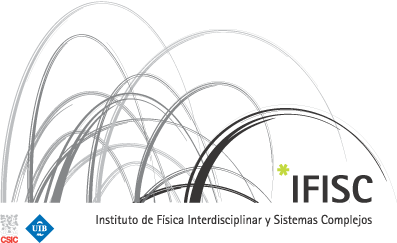The Model
The voter model1,2 can be run over any lattice or complex network, which is a set of nodes related amongst them through links. If two nodes are connected by a link, they are said to be neighbours. The number of neighbours a node has is called the degree of that node. The voter model studies the evolution3 of opinion in a group of agents (nodes). It is customary to work with two different opinions (or states), but it is possible to generalise this to as many opinions as desired. The voter model first chooses one agent and one of his neighbours at random. Afterwards, the agent will copy the neighbour's opinion and this procedure is iterated for as long as desired or until agreement of opinion is reached. Links with edges of different state are called active, and they are an important property of the voter model dynamics3, as a measure of activity in a network.
The above model will be applied over four different sorts of network.
Regular lattice
In a regular lattice, all nodes have equal degree, and are linked to their closest neighbours. Lattices show a periodic pattern, and the distance in "node-steps" is proportional to the physical distance of the nodes.
Érdös–Renyi
Érdös–Renyi networks5 are characterised by two magnitudes, the number of nodes and the number of links. That specified, links are distributed at random.
Bárabási–Albert
Bárabási-Albert networks6 are dynamically constructed from a core or seed consisting of only a few nodes. Afterwards, nodes are added to the network. New nodes are attached to a fixed number of old nodes. Needless to say, the new links are distributed at random, with uniform probability.
Watts–Strogatz
Watts–Strogatz networks7 are generated from a circle of nodes (which might be regarded as a one-dimensional lattice). The nodes can be initially linked to neighbours up to the distance desired. Then links are rewired to a new node -avoiding self and multiple connections- with a given probability.
References:
- Clifford, P., and A. Sudbury, "A model for spatial conflict", Biometrika 60(3), 581, 1973.
- Holley R and Liggett T M, "Ergodic Theorems for Weakly Interacting Infinite Systems and the Voter Model", Ann. Probab, vol 3, No. 4, 643-663, 1975.
- Suchecki, Krzysztof; Eguíluz, Víctor M.; and San Miguel, Maxi. "Voter model dynamics in complex networks: Role of dimensionality, disorder, and degree distribution". Physical Review E 72, 036132, 2005.
- Vázquez, F. and Eguíluz, Víctor. "Analytical solution of the voter model on uncorrelated networks". New Journal of Physics, 10, 063011, 2008.
- Erdos, P. and Renyi, A. "On random graphs". Publicationes Mathematicae Debrecen, 6:290, 1959.
- Barabási, A. L. and Albert, R. "Emergence of scaling in random networks". Science, 286:509, 1999.
- Watts, D.J.; Strogatz, S.H. "Collective dynamics of 'small-world' networks". Nature, 393(6684):409-410, 1998.
- Vázquez, F.; Eguíluz, Víctor M.; San Miguel, Maxi."Generic Absorbing Transition in Coevolution Dynamics". Physical Review Letters, 100, 108702, 2008.
- Vázquez, F.; González-Avella, J. C.; Eguíluz, Víctor M.; San Miguel, Maxi."Collective Phenomena in Complex Social Networks". Submitted, Springer Verlag, 2008.
- Suchecki, K.; Eguíluz, Víctor M.; San Miguel, Maxi."Conservation Laws for the Voter Model in Complex Networks". Europhysics Letters 69, 228-234, 2005.

